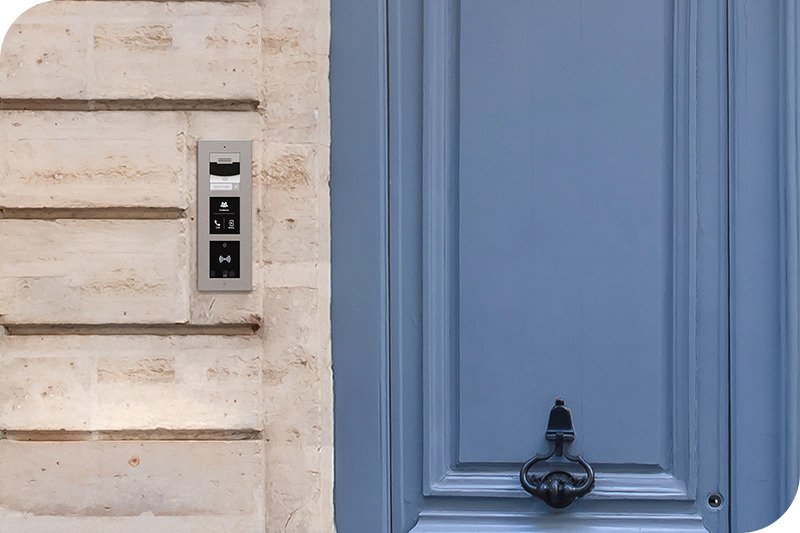Video Intercom Systems for Apartments: Retrofit Edition
 Camilla Ashdown, 24. 03. 2023 | 9 min read
Camilla Ashdown, 24. 03. 2023 | 9 min read
Want a video intercom system for apartments but dealing with old, historically valuable buildings? Modern features aren’t limited to only modern homes. Let us show you how to get the best modern features in retrofit projects!

Why do old apartments need IP video intercom systems?
You might be tempted in thinking that old buildings are better suited to retro intercoms – however, this just isn’t the case. Whilst period features might make a nice spread in an interior design magazine, when it comes to accessing the building, people want speed, ease of use, strong security, and convenience. An IP-based system uses the internet protocol to transmit data, which means it's more secure, efficient, and scalable.
This is where a good IP video intercom can come in. The right one should be sleek and modern, yet not too flashy or overstated. But, aside from looks, it should also be a powerful, secure, and highly reliable device. Secure common areas such as garages with access readers and equip residents with indoor stations in their apartments (plus a mobile app for remote control of their doors) and there you have it – a complete IP video intercom system for apartment s that looks good, but more importantly, works well. But how to install it?
First and foremost, if your old apartment building still has an analogue intercom system, it's time to upgrade. Analogue systems are outdated and don’t offer anywhere near what a good IP system can, in terms of features and security benefits. Plus, they lack the advanced features that modern video intercom systems offer. So, the first step is to convert your analogue system to an IP-based one.
What are the problems with installing an IP intercom system into a retrofit building?
Mainly, the issue lies with cabling. Old buildings usually have old cabling, that needs to be converted somehow into IP-capable cabling (more on that below.) Re-cabling an entire apartment building to install a video intercom system requires a lot of work that can be very expensive – not to mention bothersome to existing residents or neighbours.
Also, it’s often the case that historically valuable or protected buildings have strict limitations on reconstruction – meaning you can’t drill into the walls at all.
So, what’s the solution?
Converting to IP using existing 2-wire cabling
Connecting two devices
To connect individual devices (typically one intercom and one indoor station ), a paired IP to analogue signal converter is sufficient. Simply connect the intercom at the door to the converter using an Ethernet cable. Connect the same converter to the existing 2wire cable and connect the other converter on the other side of the cable. You then connect this converter to the indoor station with an Ethernet cable.
IP intercom <-> converter <-> 2-wire cable <-> converter <-> IP indoor station
Connecting multiple devices in apartment buildings
Use adapters and switches to connect multiple devices (typically one intercom at the entrance and several indoor stations in the apartments). Connect the IP intercom and indoor stations to the adapters and the adapters to the existing cables. Then place the switch in a convenient location where all the 2-wire cables meet (for example, somewhere in the utility room or at the electrical switchboard). Connect the 2-wire cables to the switch. You can use several switches in a larger project, for example, one per floor.
Use cloud platforms: no cabling required!
Using a cloud calling service via a remote management platform ensures that each product you’re installing only needs to be connected to the internet (no matter the provider) to communicate with each other - and they don’t need to be connected to each other via a cable.
A cloud platform also allows you to remotely manage and monitor all your devices remotely. This makes it much easier to troubleshoot issues, update software, deal with customer requests, and manage access control settings – and can save on travel costs.
A cloud platform also allows you to scale your system as your building grows. You can easily add new devices and users without having to install anything physically.
 Stay up-to-date with the latest news. Subscribe to our newsletter.
Stay up-to-date with the latest news. Subscribe to our newsletter.
Installing indoor stations in apartments
In cases where you don’t want to (or rather, can’t) drill into the wall? You need a product that can be installed on the wall directly rather than flush mounted – or even placed on a stand. Installing products on the wall is less inconvenient for residents, and the installer will spend less time in residents’ apartments, making it easier to set up appointments and save on installation costs.
You could also make end-users’ phones into indoor stations by using a mobile app that enables them to receive calls from IP Intercoms – even when they’re not at home (an extra benefit standard indoor stations just can’t offer!) Apps like this also allow for things like video messaging, call history and even the option to stream the video feed from intercoms installed at entrances so they can stay in contact and have an overview of their homes no matter where they are in the world.
What do end-users want from access control?
So, what do residents want from their access control? It’s tempting to say that they want something that looks good – and whilst that should be a priority, your first and foremost concern should always be security. They want to feel safe and secure in their own homes, and a modern video intercom system for apartments can provide that. They also want convenience. They don't want to carry around keys or access cards, and they want to be able to easily grant access to their guests easily without running into issues.
Giving your residents a modern IP video intercom system for apartments gives them all this: meaning they can both live in a beautiful old building and take advantage of the convenience IP access control brings.
The best features of an IP video intercom system for apartments
A good camera
A good IP video intercom should have a good camera. Of course, it’s dependent on the requirements of the project (some don’t need a camera at all), but if you need one, choose a good one. Some video intercoms can come with wide-angle, WDR-capable, full-HD cameras: which adds an advantage to the next two features we’ll mention…
Video messaging
The right indoor station can provide the option for visitors to leave video messages when residents aren’t home!
Remote home monitoring & control over doors
Another great feature is video monitoring of a resident’s surroundings. Connect to the video intercom installed at the door and check up on what’s going on in the home using an indoor station or mobile app that allows for video monitoring (as mentioned before). Some can even connect to other IP cameras elsewhere – giving residents total home surveillance. It's a great way to ensure the safety of your residents and prevent theft and vandalism.
Mobile apps also allow residents to be able to answer their doors from anywhere – allowing them to be in contact with their homes, no matter where they are. They’ll never miss a delivery person again!
Mobile access
Another important feature is mobile access. This allows residents to enter the building using their mobile phones, which is much more convenient than carrying around keys or access cards. Mobile access can also be secure, reliable, and fast: just choose the right provider that uses the right technology.
Multi-user access
Giving residents who live in often busy apartment buildings flexibility is important. A good video intercom system for apartments should include things like one-time QR code / PIN code access for visitors such as cleaners or delivery people as well as the more permanent methods residents use (such as mobile or RFID cards). A modular intercom, and access readers that can support multiple access technologies, are good choices if you want to offer residents this useful feature.
To conclude
In conclusion, installing a video intercom system in an old apartment building is a great way to improve security and convenience for your residents. By converting your analogue system to an IP-based one, you'll be able to take advantage of the latest features in access control, such as mobile access, remote control over entrances, and video surveillance. And by using a cloud platform to manage your devices, you'll be able to easily scale your system and optimize its performance. Thanks for reading, and good luck with your installation!